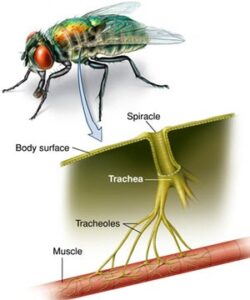Single-celled Organisms Gas Exchange
Since gas exchange occurs by diffusion alone, single-celled organisms such as bacteria do not need any specialised structures to achieve it for them. This is because, being so small, diffusion occurs readily as their surface area to volume ratio is high.
The distance between an oxygen molecule which must be taken in, and the place it must get to within a bacterium is short enough for diffusion to be a viable way of exchanging substances with the environment, without the need for additional structures. In mammals, for example, oxygen cannot simply diffuse into our bodies. We are too large, have a low surface area to volume ratio, hence the diffusion pathway is too long. The only way we can achieve gas exchange is through our lungs which provide a large surface area and alveoli with short diffusion pathways.
In fact, the difficulty of gas exchange as single-celled organisms get larger is a factor which leads to larger organisms being multicellular.
Insect Gas Exchange
Before this goes any further, a few clarifications:
- Gas exchange is central to life. Oxygen is needed in respiration* which generates usable energy without which life wouldn’t exist. Removing the resulting carbon dioxide is crucial too.
- Water can be a gas too, in the form of water vapour. This may in certain organisms escape with the air, so water preservation versus gas exchange is always an important thing to bear in mind. This is especially important when talking about insects and plants.
